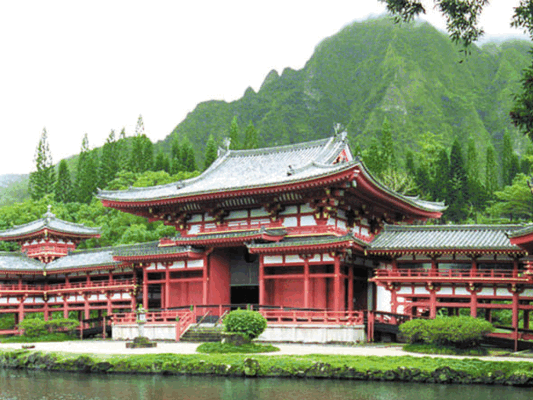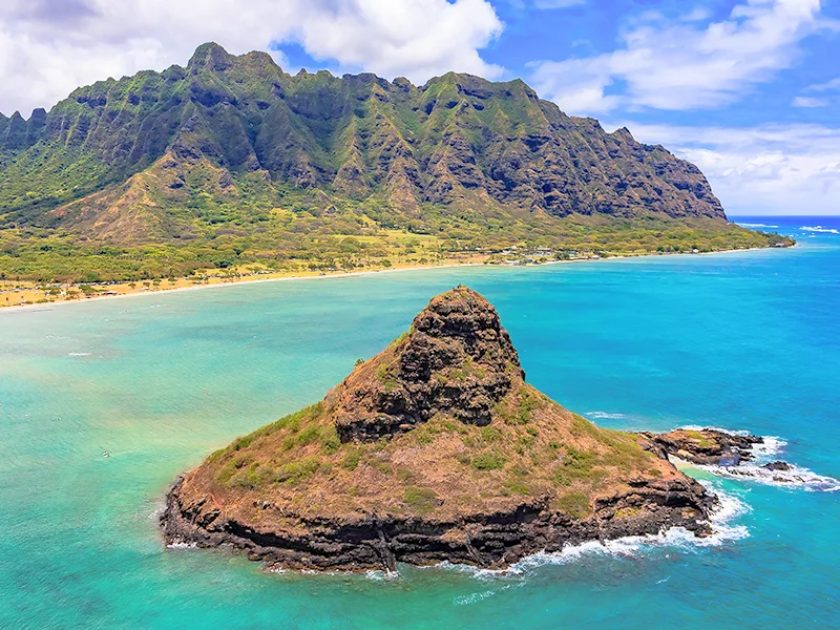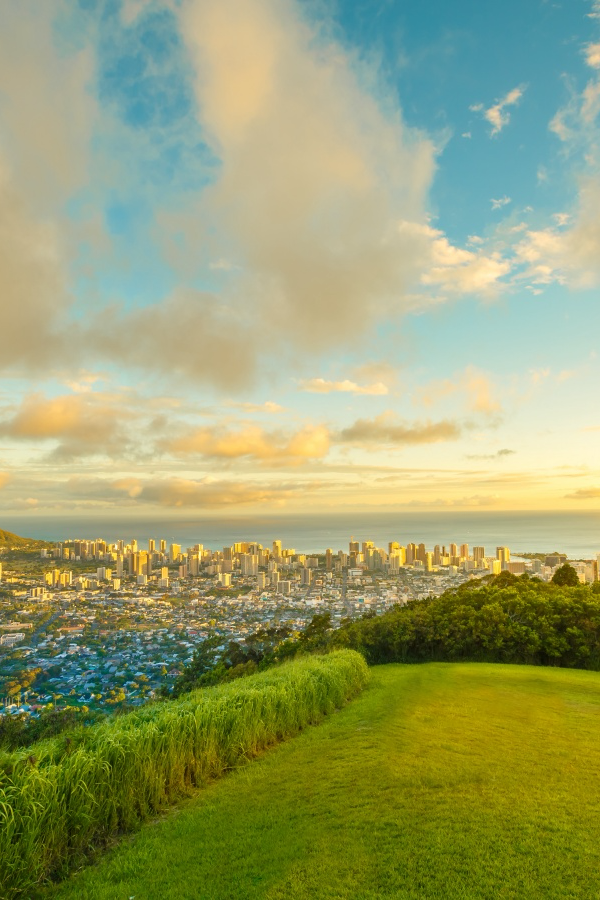Discover the mesmerizing Byodo-in Temple in Oahu, Hawaii, where traditional Japanese architecture and culture come to life. This magnificent temple was erected in 1968 to honor the centennial anniversary of the first arrival of Japanese immigrants in Hawaii, becoming a powerful symbol of peace and intercultural understanding. Immerse yourself in its enchanting gardens, experience unparalleled tranquility, and marvel at its awe-inspiring architecture. It’s no surprise that millions of visitors flock to Byodo-in Temple each year. Whether you are a history enthusiast or a spiritual seeker, this is a must-visit destination during your time in Oahu. Uncover its rich cultural heritage or simply bask in its exquisite beauty, the Byodo-in Temple has something remarkable to offer for everyone.
Highlights
- Take a stroll around the temple’s beautiful gardens with koi ponds and lush greenery that create an atmosphere of peace and tranquility
- Find a large Buddha statue as well as other artifacts from Japanese culture such as paper lanterns, drums, bells, and calligraphy scrolls
- Take part in traditional ceremonies like ringing the bell for good luck or offering incense sticks during prayer time
- Enjoy a unique experience that beautifully blends Japanese culture with Hawaiian history
History
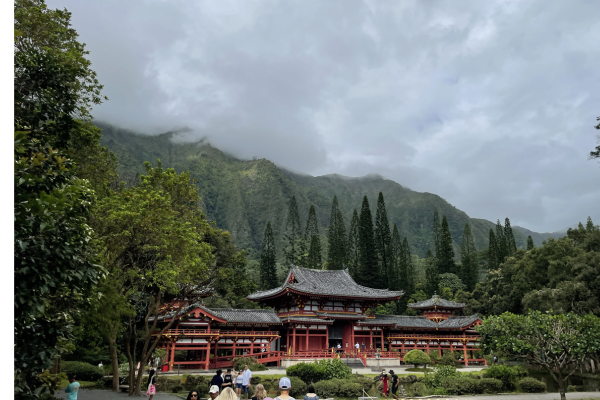
Byodo-in Temple in Hawaii was built to commemorate the 100th anniversary of the first Japanese immigrants arriving in the Hawaiian Islands. The original Byodo-in Temple, located in Uji, Kyoto Prefecture of Japan, was constructed over 1,000 years ago and is an architectural masterpiece known for its serene atmosphere and beauty. In 1968, a smaller version of this temple was built on the island of Oahu in Hawaii as part of a memorial park called “Valley of the Temples”.
The Byodo-In Temple, meaning “Temple of Equality – not to discriminate,” welcomes visitors of all backgrounds without regard to religious beliefs or spiritual affiliations. The Hawaiian version of this temple, however, is not used for religious ceremonies or rituals like its Japanese counterpart. Instead, it serves more as a peaceful sanctuary where anyone can come and meditate or take refuge from their busy day-to-day lives. Inside the temple is a Meditation Pavilion where visitors can sit down and reflect on their lives and surroundings. Along with beautiful gardens full of trees, flowers, and waterfalls that surround the building itself, Byodo-in Temple offers a tranquil environment to anyone who visits this sacred place.
Exploring the Architecture of Byodo-in Temple
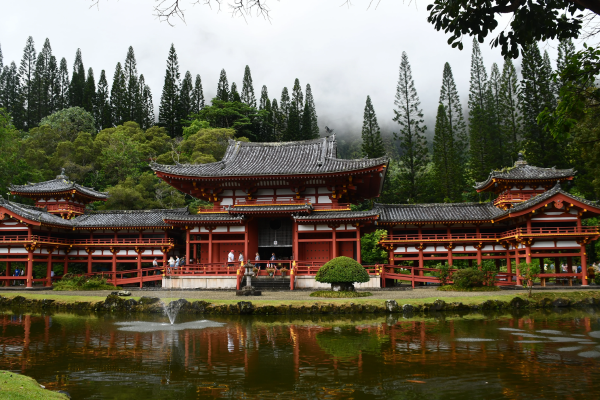
The architecture of Byodo-in Temple is inspired by one of the oldest existing wooden temples in Uji, Kyoto Prefecture, Japan. The two-story main building has a unique design with distinct curves throughout. It features a large bell tower at its entrance that serves as an important element in Buddhist ceremonies called bon-sho. Inside the temple complex are several smaller buildings such as a prayer hall with statues depicting various Buddhas, a five-storied pagoda that reaches 35 feet high, and three bridges that cross over a peaceful reflecting pond. In addition to its impressive design features, Byodo-in Temple also boasts vibrant gardens filled with lush plants and colorful flowers along with an abundance of koi fish swimming about in its ponds.
The Symbolism Behind the Phoenix Hall of Byodo-in Temple
The Phoenix Hall, also known as Hōōdō (“Hall of the Twin Phoenixes”), is one of the most remarkable architectural structures within Byodo-in Temple. It stands as a symbol of peace and harmony, representing Buddhist teachings about life and death. Its two phoenixes represent yin and yang—the opposites that intertwine to create a balanced universe. Built using traditional Japanese construction techniques, the Phoenix Hall consists of two separate halls: The Amida (or Main) Hall where an 11-foot golden statue of Amida Buddha resides; and the Kannon (or Auxiliary) Hall, dedicated to Avalokiteśvara, Bodhisattva of Compassion. Both halls are connected by a courtyard with a lotus pond surrounded by five stone lanterns, each representing one of the five elements – fire, earth, water, wind, and wood.
The Phoenix Hall is considered an architectural masterpiece and its ornate beauty has made it one of Byodo-in Temple’s most iconic symbols. It serves as a reminder that beauty can be found in every aspect of life – even in death itself. Visitors can find further insight into this concept through participating in chanting rituals at the temple or guided tours offered onsite by certified docents. Festivals such as Obon (a festival for honoring ancestors) are held annually at Byodo-in Temple and visitors are encouraged to celebrate these special occasions with reverence for their cultural heritage.
Things to Do
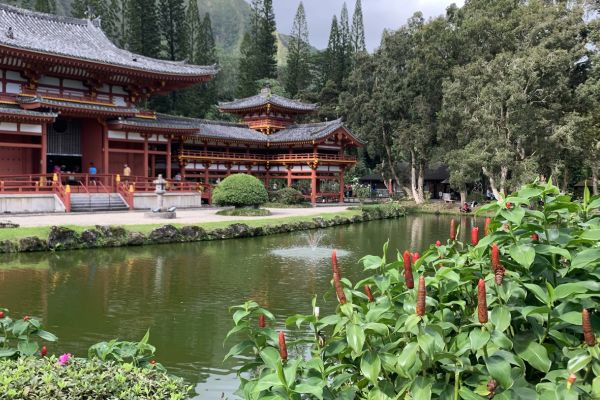
Take Part in the Temple’s Meditation and Chanting Sessions
Byodo-in Temple sessions offer a unique opportunity to deepen one’s understanding of Buddhist teachings and bring inner peace. During these sessions, visitors will be guided on how to meditate and chant Buddhist scriptures such as the Heart Sutra and Prajnaparamita Sutra. Afterward, they can participate in traditional rituals such as offering incense and ringing a bell of contemplation. These practices help create a sense of spiritual connection with the divine energy that is often felt throughout the temple grounds.
Additionally, Byodo-in Temple hosts many special events throughout the year that give visitors an even more intimate experience with Buddhism. Special ceremonies such as memorial services are held on occasion for those who wish to pay their respects or give thanks to their ancestors. On certain days, there are also lectures given by monks which provide an opportunity for attendees to learn more about Buddhist philosophy in depth. These events serve as another great way for people to deepen their faith while connecting with others of similar beliefs.
Experience Traditional Japanese Tea Ceremonies
Byodo-in Hawaii offers a unique experience that brings together the ancient and modern aspects of Japanese culture. At the temple, visitors can take part in traditional Japanese tea ceremonies that have been part of the country’s cultural heritage for centuries. The tea ceremony is a reflective and spiritual ritual that allows one to contemplate their own thoughts and emotions while drinking tea in an atmosphere of tranquility.
You will be partaking in a centuries-old tradition of serving green matcha tea to guests with its powdered form dissolved in hot water and served with wagashi (Japanese sweets) as accompaniment. The serene atmosphere at Byodo-in Hawaii makes it an ideal place to appreciate the beauty of Japanese culture, as well as reflect on life’s greater purpose. Through experiencing traditional tea ceremonies here, visitors can reconnect with their inner self while being surrounded by nature’s beauty and Japan’s cherished customs.
Celebrate Obon Festival at Byodo-in Temple
Every summer, visitors come from around the world for Obon, a traditional festival celebrating the spirits of one’s ancestors who passed generations ago. During Obon, visitors can take part in events such as traditional dancing, bon odori (lantern procession) and illumination ceremonies where lanterns are lit up and floated down streams or ponds representing the ancestors’ journey into the afterlife. It is a joyous celebration where families come together to honor ancestral heritage and create lasting memories. Experience ancient traditions and pay homage to your loved ones in a vibrant atmosphere filled with happiness and unity. This is also a reminder of the importance of respecting nature while connecting on a deeper spiritual level.
Simply Wander Around the Beautiful Grounds
Byodo-in Temple is a perfect destination to simply wander around the beautiful grounds. The main hall houses a nine-foot-tall statue of Amida Buddha – said to bring luck and ward off evil spirits. Visitors can also explore the inner courtyard garden featuring a pond with lotus flowers, various native plants, and five impressive stone lanterns which symbolize the five elements: fire, earth, wind, metal, and wood.
Guided tours offered by certified docents provide visitors with detailed educational information about Byodo-in history and spiritual significance. Special events such as outdoor movies and artist exhibits are held at the temple throughout the year making it an ideal place for relaxation and learning. As one of Hawaii’s most iconic landmarks, guests can take in majestic views of lush greenery while basking in the unique spiritual atmosphere that makes it a sacred destination for all who visit.
Tips for First-time Visitors
Visiting Byodo-in Temple is a unique and memorable experience and one that should not be missed while in Hawaii. Here are some tips to make the most of your visit:
- Arrive early – Byodo-in Temple opens daily from 8 am to 6 pm and it is best to arrive with plenty of time to explore. During peak season, the temple gets crowded quickly so if you want to avoid the crowds, arrive early.
- Dress appropriately – Byodo-in Temple is a sacred site where respect is expected. While there is no dress code it is advised to dress modestly. You will also be required to remove your shoes before entering the temple.
- Take time for contemplation – Visit the main hall as well as the inner courtyard garden and take some time for peaceful reflection. The spiritual atmosphere of the temple can be felt by those who take the time to appreciate it fully.
- Bring cash – Cash is required for donations at each entrance gate.
Follow etiquette guidelines – Talking loudly or running around is discouraged while visiting the temple grounds. Taking pictures is allowed using handheld cameras and phones, but drones are prohibited.
Best Souvenirs From a Visit to Byodo-in Temple
The former Japanese tea house now transformed into a charming gift shop is located on the left side of the Temple. To ensure that your memories of this beautiful landmark remain intact, there are a variety of souvenirs that can be purchased as mementos of the visit.
- Miniature Buddha statues – The most popular souvenir among visitors to Byodo-in is a replica of the Amida Nyorai Buddha statue found in the main hall. Crafted from bronze or copper, these statues come in a range of sizes and can provide a spiritual reminder of your time spent at this remarkable temple.
- Handcrafted jewelry – Another popular item is handcrafted jewelry made with natural gemstones such as jade and obsidian, which are believed to bring peace and luck. These pieces often feature symbols associated with Byodo-in Temple such as lotus blossoms and dragons.
- Stone lantern – For something unique, visitors may want to purchase a stone lantern or one of the temple’s signature incense sticks, which are said to bring health and harmony.
- Prints and artworks – Prints of artwork by local artists depicting Byodo-in stunning architecture are also available as lasting reminders of its beauty.
- Traditional Japanese clothing – Discover a variety of traditional Japanese wedding attire including gowns, kimonos, happi coats, and Ichi-ban headbands available for purchase.
Frequently Asked Questions (FAQs)
Byodo-in Temple opened its doors to visitors in 1968 after five years of construction inspired by ancient Japanese architectural principles.
Visiting Phoenix Hall and Hoshokan Museum can be a 40 to 50-minute experience, but the time spent can vary depending on personal interest. For a more immersive visit, including exploring the sub-temples, browsing the museum shop, and relaxing with a cup of tea plan on spending 90 to 120 minutes.
Uncover the rich cultural history of Hawaii at Byodo-In Temple, situated in the picturesque Valley of the Temples Memorial Park. A captivating tribute to Japan’s legacy on the island, this striking temple was constructed to honor the centennial of Japanese immigration to Hawaii.
The Temple Grounds are open every day from 8:30 am to 5:00 pm, with the last entrance at 4:45 pm. While taking in the serene atmosphere, stop by the Gift Shop, which is open from 8:30 am to 5:00 pm daily. For General Admission, the fee is $5.00 for ages 13-64. Seniors (age 65 & up) pay $4.00 and children aged 2-12 are $2.00.
Personal phones and hand-held cameras are often exempt from license requirements. Drones aren’t authorized. Visit the Photography Permits website for additional details.
How to Get There
The Byodo-In Temple
Located in: Valley of the Temples Memorial Park
Open every day, 8:30 AM–4:30 PM
Official Website
By Car
Byodo-in Temple is just a short thirteen-mile drive from the airport. Follow the H1 Honolulu East freeway, take the Likelike Highway exit, and continue through the Wilson Tunnel. Take the Kahekili exit and stay on the left lane to find the temple on your left, with the serene Valley of the Temple’s Cemetery beside it.
Alternatively, enjoy a scenic drive over the mountains via the Pali Highway, taking the Kaneohe exit, and continuing on H-3 past Windward Community College. Turn left on the Ave of the Temples, and you’ll find the Byodo-in Temple at the end of the road, with ample parking.
By Bus
To get to the Valley Of The Temples Memorial Park, the most recommended public transportation is the Bus. The fare is $2.50, so having a small change in your pocket is a good idea.
From Waikiki, take Bus #8 to Ala Moana Shopping Center, then take Bus #65 towards Kahaluu/Kaneohe. Get off at the last stop and walk across Kahekili Highway, then continue on a gentle uphill walkway into the valley. If you take Bus #55, ask the driver for a “Transfer Ticket” if you need to switch to Bus #65 later on. If you reach the Higenic Store area, wait for #65. Otherwise, take #55 towards Laie, Kahuku, and Turtle Bay Hilton.
Although the trip takes 1.5 to 2 hours from Waikiki, compared to 30 minutes by car or taxi (approximately $40 one-way), the Bus is an affordable option that allows you to sit back, relax, and enjoy the scenic route.
Experience the Beauty of Byodo-in Temple Hawaii!
Byodo-in Temple is truly an unforgettable destination for travelers looking to experience Japan’s cultural heritage while being surrounded by breathtaking Hawaiian landscapes. We invite you to visit this unique sanctuary and experience its history and beauty firsthand!


